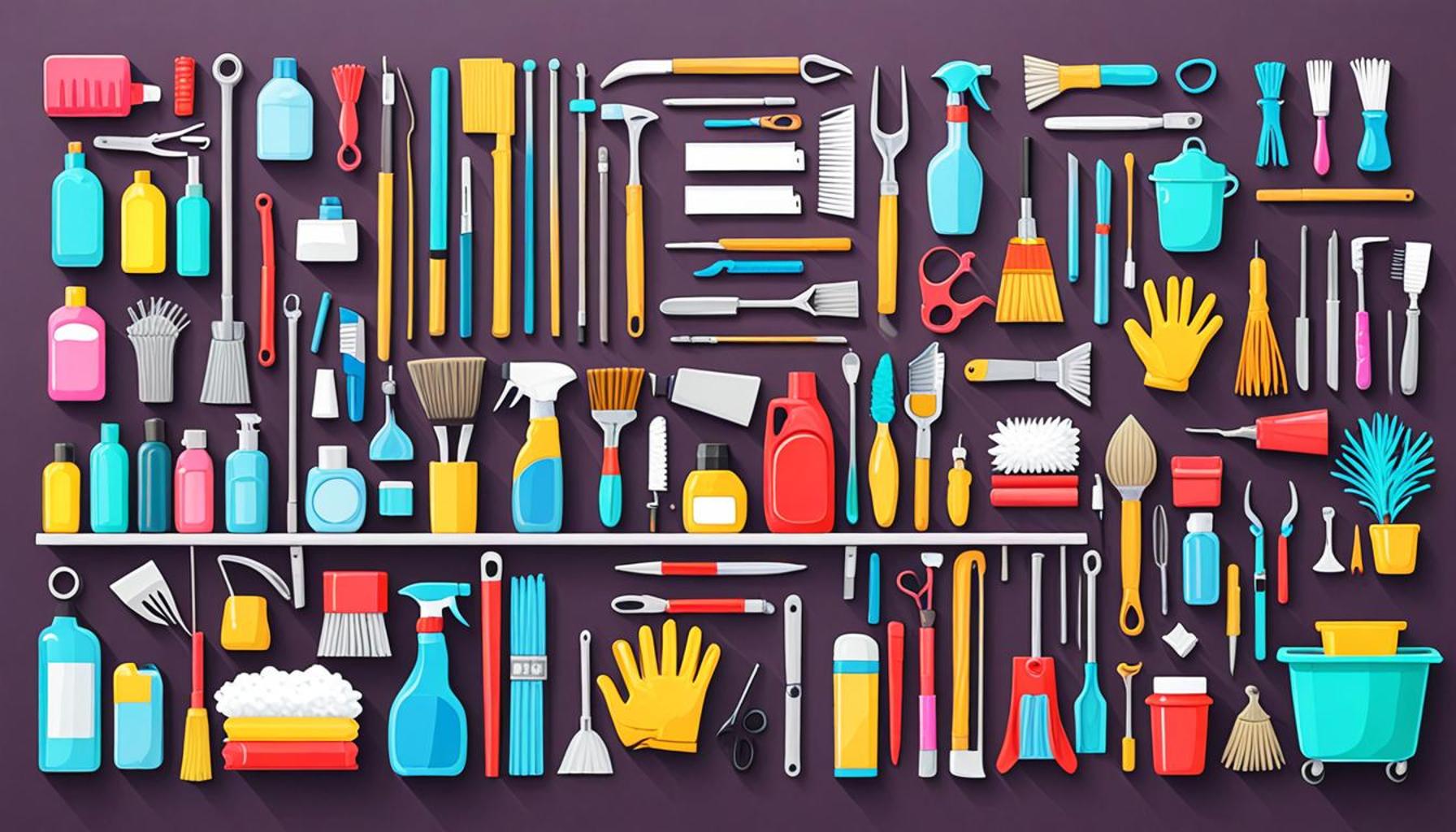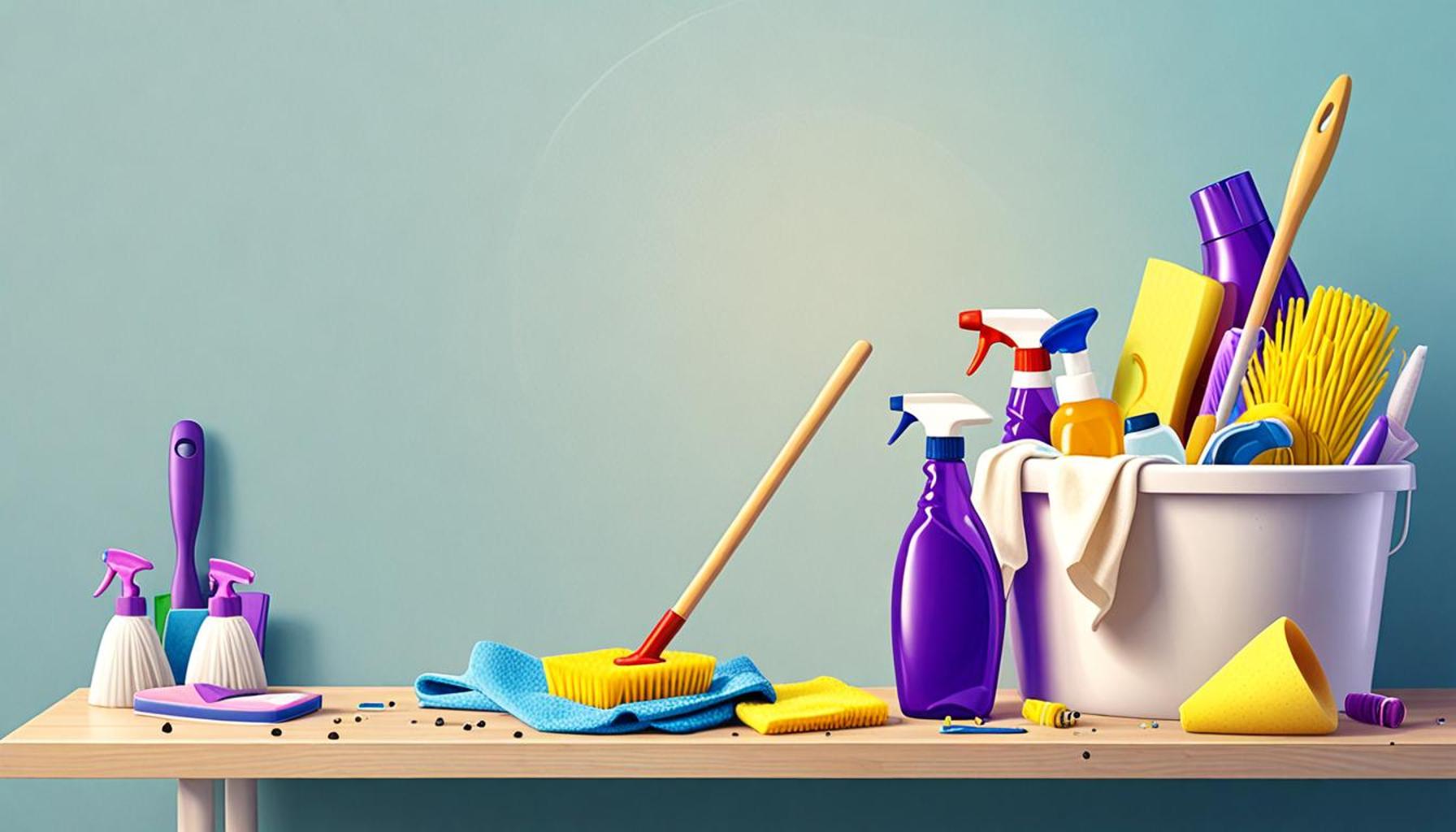Organization and Cleaning: How to Create an Effective Maintenance Schedule

The Importance of an Effective Maintenance Schedule
Maintaining a clean and organized space is crucial for productivity and mental clarity. However, without a solid plan, it can quickly become overwhelming. An effective maintenance schedule can transform chaos into order, helping you regain control over your environment.
Creating a structured routine allows you to stay on top of household chores and workplace tasks. This structure not only provides a sense of accomplishment but also fosters a positive mindset. Consider these key benefits:
- Reduces Stress: A clear plan minimizes the anxiety associated with clutter. Studies have shown that a tidy space can significantly lower cortisol levels, which are correlated with stress. For example, coming home to a clean kitchen can create a calming atmosphere that allows for relaxation after a long day.
- Enhances Productivity: Regular cleaning boosts focus and efficiency. When workspaces are organized, people tend to work faster and more effectively. For instance, office employees with organized desks report a 20% increase in productivity, as they spend less time searching for items.
- Improves Health: A clean environment can prevent illness and allergies. Dust, mold, and allergens can accumulate in unclean spaces, leading to respiratory issues. Regular cleaning diminishes this risk, supporting overall well-being and reducing sick days.
Building Your Maintenance Schedule
To start building your maintenance schedule, it’s essential to identify the various areas in your space that require attention. This includes not only the home but also workplaces and common areas. Consider the following:
- Daily Tasks: Engage in small daily chores such as doing the dishes, dusting surfaces, and tidying up clutter. These minor yet crucial tasks accumulate to create a significantly cleaner environment.
- Weekly Activities: Set aside time each week for tasks like vacuuming, doing laundry, and deep cleaning bathrooms. For example, designating Saturday mornings for these activities can establish a habit while freeing up the rest of your weekend.
- Monthly Goals: Plan for more substantial tasks such as organizing closets, cleaning windows, and maintaining appliances. Consider using the first Monday of every month to tackle one major chore, which can prevent overwhelming workloads.
Effective Strategies for Implementation
By categorizing tasks, you pave the way for a systematic approach to cleaning. This method not only helps you remember what needs to be done but also when it should be completed. To ensure that your maintenance schedule is successful, consider these strategies:
- Leverage Technology: Use apps or digital calendars to set reminders for specific tasks. Technology can help track your progress and allow for easy adjustments to the schedule as needed.
- Build a Team: In households, involve family members in the cleaning routine. Assign specific tasks tailored to each person’s strengths. This not only lightens the load on individuals but also fosters teamwork.
- Review and Adjust: Regularly assess and adjust your maintenance schedule to accommodate changes in your life, work, or family dynamics. Flexibility is key to staying organized.
An effective maintenance schedule can significantly impact your quality of life. By understanding the benefits and implementing structured strategies, you will not only create a clean environment but also promote a more organized and productive lifestyle. This holistic approach encourages you to nurture both your personal spaces and your mental well-being, leading to harmonious living.

CHECK OUT: Click here to learn how to create a flexible maintenance plan
Building Your Maintenance Schedule
Creating an effective maintenance schedule does not have to be a daunting task. To kick off this process, it is vital to assess your environment and pinpoint the areas that require regular attention. From homes to workplaces, every space can benefit from a carefully crafted plan. Here are some essential steps to consider when building your maintenance schedule:
- Identify Priority Areas: Start by determining which areas need the most frequent care. For instance, in a home, the kitchen and bathrooms are typically high-traffic zones that require daily or weekly cleaning to prevent the buildup of grime and bacteria. On the other hand, less accessed rooms like storage areas or guest bedrooms may require less frequent attention.
- Divide Tasks into Categories: Break down your cleaning obligations into manageable segments. Create lists that categorize chores into daily, weekly, and monthly tasks. This division allows for a systematic and less overwhelming approach. Daily chores could include washing dishes and making beds, while weekly tasks could entail vacuuming and laundry.
- Set Realistic Goals: When formulating your schedule, ensure that the goals you set are achievable. For example, if you know that weekends are typically busy with family activities or social gatherings, planning extensive cleaning sessions then might lead to frustration. Instead, consider shorter maintenance sessions throughout the week.
- Make Room for Flexibility: Life can be unpredictable, and so can your cleaning schedule. It’s important to design a plan that can adapt to changes. If Mondays become hectic due to work commitments, think about shifting your cleaning tasks to another day without guilt. Flexibility ensures that you maintain consistency without adding stress.
Daily Tasks: The Foundation of Cleanliness
Daily tasks may seem small, but they form the backbone of a clean and organized space. Engaging in small chores every day ensures that messes do not accumulate. Some key daily activities to incorporate into your routine include:
- Quick Decluttering: Spend 10-15 minutes each day putting items back in their designated places. This practice not only maintains order but also sets a positive tone for the day ahead.
- Surface Wipes: Wipe down kitchen countertops and bathroom surfaces each day to prevent the buildup of dust and grime. This simple act can significantly enhance the overall cleanliness of your space.
- Dish Duty: Establish a habit of washing dishes immediately after meals or loading them into the dishwasher right after use. This goes a long way in ensuring the kitchen remains orderly and welcoming.
By establishing and sticking to these daily habits, you cultivate an environment that not only looks clean but also feels serene. The effort put into daily maintenance decreases the need for extensive cleaning sessions later, thus promoting a proactive approach to organization and maintenance.
Weekly and Monthly Maintenance: Planning for Success
While daily tasks lay the groundwork for a tidy space, weekly and monthly activities ensure that deeper cleaning takes place. Weekly tasks often involve thorough cleaning of high-traffic areas, while monthly tasks can cover more extensive cleaning duties. Consider this outline for planning:
- Weekly Cleaning: Dedicate time each week to focus on vacuuming, dusting, laundry, and cleaning bathrooms. Even carving out one or two hours over the weekend can lead to significant improvements in your environment.
- Monthly Maintenance: Reserve one day each month for deep cleaning projects such as organizing closets, cleaning appliances, or tackling small repairs. Assign a specific date, like the first Saturday of each month, to maintain a routine.
This structured approach provides not just a cleaner environment, but a maintained sense of calm and well-being. An effective maintenance schedule empowers you, encouraging a lifestyle where organization and cleanliness are integral parts of everyday living.
| Category | Details |
|---|---|
| Time Management | Creating a maintenance schedule allows for efficient allocation of time. This ensures that all cleaning tasks are completed systematically. |
| Increased Productivity | A well-structured maintenance plan promotes higher productivity as team members know their responsibilities and deadlines. |
| Improved Quality | Regular maintenance translates to consistent performance of cleaning tasks, leading to a cleaner and healthier environment. |
| Cost Efficiency | An effective maintenance schedule minimizes the need for costly repairs due to regular upkeep, ensuring long-term savings. |
The implementation of an effective maintenance schedule fundamentally transforms organization and cleaning priorities within any setting. One advantage is time management; actively planned schedules allow for a meticulous allocation of time toward cleaning and maintenance tasks. This not only ensures tasks are completed systematically but also allows for a structured workflow that enhances productivity.In addition, teams benefit from a clear understanding of their responsibilities and deadlines, fostering an environment where collaboration thrives. Regular upkeep plays a crucial role in maintaining the quality of cleanliness, ensuring that all aspects of the environment are consistently addressed. Ultimately, this shift towards a routine not only enhances aesthetics but also promotes a healthier space. Moreover, the financial aspect cannot be ignored. By adopting an effective maintenance schedule, organizations significantly reduce costs associated with unexpected repairs and replacements, paving the way for long-term investment in cleanliness and hygiene practices.
DISCOVER MORE: Click here to learn about eco-friendly packaging solutions
Incorporating Tools for Efficiency
To optimize your maintenance schedule further, consider leveraging various tools and technologies that can automate or simplify your cleaning tasks. From scheduling apps to smart home devices, there are numerous resources available that can enhance your efforts. Here are some strategies to integrate technology into your cleaning routine:
- Utilize Cleaning Apps: Several apps are designed to help you create personalized cleaning schedules. Apps such as Todoist or Weave allow you to set reminders for daily, weekly, and monthly tasks, enabling you to stay on track without the hassle of paper checklists. These tools can also let you share your schedule with family members, promoting team effort in maintaining a clean environment.
- Consider Smart Devices: Smart home technology, such as robotic vacuums or smart air purifiers, can perform tasks on your behalf. Devices like the Roomba can be scheduled to clean your floors while you are away, ensuring that upkeep is automated. Smart refrigerators and laundry machines can also keep track of usage and alert you when maintenance is needed, making the entire process more coordinated.
- Timer Techniques: Implementing the Pomodoro Technique—working in focused bursts followed by short breaks—can make mundane cleaning tasks feel more manageable and less overwhelming. For example, set a timer for 25 minutes of cleaning, followed by a 5-minute break. This method keeps productivity high while preventing burnout.
Encouraging a Team Effort
A maintenance schedule is more effective when it’s a collective effort rather than a solo endeavor. Engaging family members or colleagues can help distribute the workload, leading to a more harmonious environment. Here’s how to foster teamwork in your cleaning strategy:
- Assign Specific Roles: Clearly define cleaning responsibilities based on individual strengths or preferences. For example, someone who enjoys cooking may take charge of kitchen upkeep, while another might excel at organizing spaces. This division not only enhances efficiency but also instills a sense of ownership and pride.
- Hold Cleaning Challenges: Turn cleaning sessions into fun competitions or challenges among family members or coworkers. Consider timing how long it takes to complete a particular task and reward the quickest or most thorough performer. This fosters a spirit of collaboration while tackling maintenance chores.
- Regular Check-ins: Schedule meetings to discuss the effectiveness of your cleaning schedule, allowing for adjustments as necessary. This ensures that everyone remains engaged, and responsibilities are shared equitably. Regular feedback maintains accountability and enthusiasm.
Evaluating and Adjusting Your Schedule
Your maintenance schedule is not set in stone; it should evolve based on your needs and experiences. Periodically reviewing its effectiveness is essential to ensure it continues to serve its intended purpose. Consider these evaluation strategies:
- Track Your Progress: Keep a log of completed tasks or use checklists to visually see your accomplishments. This can motivate you, as it provides an overview of what has been achieved and what still needs attention.
- Solicit Feedback: Ask for input from your family or coworkers about the cleaning schedule. They might suggest adjustments that improve efficiency or alleviate stress, which can lead to a more cooperative atmosphere.
- Be Open to Change: Life events, such as a new job or a growing family, can impact your schedule’s viability. Stay flexible in accommodating these changes, ensuring that your maintenance plan adapts to your current lifestyle.
By incorporating these strategies into your maintenance schedule, you not only create a structured environment but also amplify your effectiveness and enjoy the advantages of a clean and organized space. Whether you rely on advanced tools, harness team collaboration, or keep your schedule adaptable, a well-maintained environment is within reach.
DISCOVER MORE: Click here for helpful tips
Conclusion
Creating an effective maintenance schedule is not just about keeping your environment tidy; it is a proactive strategy that can decrease stress, improve productivity, and foster a sense of community. By embracing a structured approach to organization and cleaning, you can transform tedious tasks into manageable routines that fit seamlessly into your lifestyle. Enhancing your cleaning strategy with modern tools, such as cleaning apps and smart home devices, offers not only efficiency but also enables automation, giving you more time to focus on what truly matters.
Moreover, encouraging a team effort by allocating specific roles can create a sense of unity, making cleaning a collaborative and enjoyable project rather than a burden. Remember, the key to sustainability lies in regular evaluation and willingness to adjust your schedule to align with life’s changes. Don’t hesitate to seek feedback and track progress; after all, maintaining an organized environment is an ongoing journey. In an ever-evolving world, staying flexible will ensure that your maintenance schedule adapts to your needs and those around you.
Ultimately, adopting these principles of organization and cleaning will help cultivate a harmonious living or working environment where cleanliness is not only a goal but a fundamental part of your daily life. Dive deeper into these strategies, experiment with them, and discover just how impactful a well-organized maintenance schedule can be for your space.


